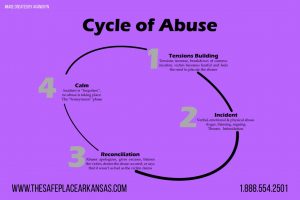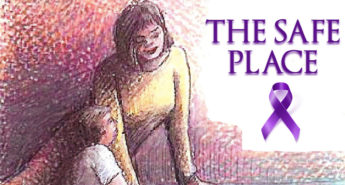 Something that may be surprising to anyone that has not been a victim of domestic abuse is that there is often a pattern to abusive behavior. That pattern runs in a cycle that may repeat itself hundreds of times during the course of a relationship that involves domestic violence. This cycle is used by the abuser to maintain power and control over the victim.
Something that may be surprising to anyone that has not been a victim of domestic abuse is that there is often a pattern to abusive behavior. That pattern runs in a cycle that may repeat itself hundreds of times during the course of a relationship that involves domestic violence. This cycle is used by the abuser to maintain power and control over the victim.
- Tension Building
This is the period when the victim may feel like they are ‘walking on eggshells’. Stress is building in the relationship and the abuser feels that they have somehow been wronged or neglected and begins to yell, criticize, tear down, pick apart, and demean the victim. The victim becomes anxious, carefully guarding everything they say or do to avoid ‘upsetting’ the abuser or ‘making’ them angry.
- Incident
At this point the abuser perceives that the victim has done something that is an affront to their control and unleashes their full rage in retribution on the victim. They may lash out through verbal, physical or sexual abuse. Statistics have shown that the incidents increase in intensity over time.
- Reconciliation
After the dust has settled after the abuse incident, if the victim is still around, the abuser will seek ‘reconciliation’. Reconciliation may or may not include an apology. The abuser may say they are ‘sorry’ and that it will ‘never happen again’. They may buy gifts or make promises of change. Other abusers will simply act as if the incident never happened. They may ‘gaslight’ the victim and tell them that they are ‘crazy’ and ‘imagining things’. (If the victim has left the relationship, the abuser may also attempt reconciliation. This may digress into to threats, stalking, and more violence if the ‘reconciliation’ is rejected. The most dangerous time for a victim is the period of time right after they leave an abusive relationship.)
- Calm
This stage of the cycle is when the abuser goes back to being the person that the victim fell in love with, is also known as the ‘Honeymoon Stage’. They may be kind, caring, be very attentive, and show lots of affection. They may begin to go to church or counseling. In the early days of the relationship, the victim usually believes that the abuser has changed. But as time progresses, trust is broken over and over again. Fear and anxiety become part of everyday life. The ‘apologies’ become less and less sincere and may not happen at all anymore. The abuser again begins to find things that ‘upset’ them and the stage of Tension Building begins again.
This cycle of abuse can repeat daily or cover weeks of behavior. For anyone who is a repeated victim of domestic violence, this may be eerily familiar. For victims in the early days of your relationship, this may be eye-opening. For those that have been trapped in the cycle for a while, this may be your nightmarish life. Whatever stage you may be in – there is hope. We can help. Call 1.888.554.2501 for help, anytime, day or night. Our Morrilton number is 501.354.1884. Our Perryville number is 501.889.2030.
https://www.talkspace.com/blog/cycle-of-abuse-domestic-violence/
https://domestic-violence.laws.com/cycle-of-violence




Leave a Reply